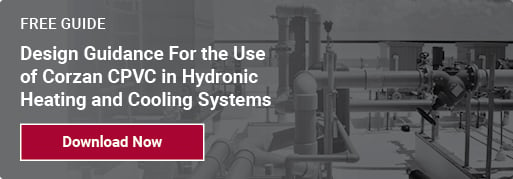How Does Chlorine Affect Plastic Piping Systems?
Chlorination is frequently employed to control the growth of harmful bacteria in cooling towers and recirculating systems. But many may not realize that this type of disinfection, relied upon to maintain healthy HVAC systems, can accelerate degradation of some types of pipes.
CPVC is not one of those piping materials. And the reason is right in its name: chlorinated polyvinyl chloride. In its very molecular structure, CPVC possesses inherent resistance to degradation by chlorinated water. Unlike other types of plastic pipes, it does not rely on sacrificial antioxidants to protect itself.
Molecular Structure and Oxidation Resistance
Plastic materials derive their strength from the fact that they are very long molecules with a chain-like structure. It is necessary to protect the integrity of that chain structure to maintain the strength and performance of a piping system. Polyolefins like polybutylene, polypropylene, and PEX have only hydrogen atoms surrounding their chain structures. Hydrogen atoms are very small and don’t serve to protect the chain at all. Furthermore, branched polyolefins, like polybutylene and polypropylene, have an abundance of easily oxidized tertiary carbons in their chain structure, so they require an even higher level of protection to resist degradation.
Therefore, polypropylene and other polyolefin materials have antioxidant additives that act as a sacrificial barrier against degradation. They protect it not only against aggressive chemicals like chlorine in the water, but also against free radicals that occur naturally in the polymer with exposure to heat or light.
Because polyolefins are much more permeable than other types of plastics, these antioxidants are able to leach out of the plastic piping into the water flowing through it. So even when aggressive oxidizers like chlorine are not present in the water, polyolefins are slowly losing their protective additives. When aggressive oxidizers like chlorine are added to the system, the protective antioxidants are destroyed even faster. Once the antioxidants are used up, chlorine or naturally occurring free radicals proceed directly to the polymer chain, breaking the molecule into smaller and smaller pieces until it loses strength and fails.
CPVC, on the other hand, inherently has lots of chlorine atoms attached to and surrounding its chain structure. Chlorine atoms are huge in comparison to hydrogen, and they actually physically block the oxidants and radicals from reaching the CPVC chain structure. CPVC also has no branching in its structure, so there are no easily oxidized tertiary carbons that require special protection. CPVC doesn’t need to rely on sacrificial additives to protect itself, so there’s nothing to dissipate and get used up over time
CPVC’s inherent resistance to oxidative degradation by chlorine solutions can be seen in the material’s 50 years of service in hot chlorinated drinking water. In addition, it’s a proven option for much more demanding chlorine-handling service in heated pool and spa water applications (which are typically chlorinated to about six times the level of normal tap water) and industrial bleaching applications (with as much as 40,000 times the levels of pool water).
Chlorine Resistance Ratings
Developed in 2000, ASTM F2023 is the Standard Test Method for Evaluating the Oxidative Resistance of Crosslinked Polyethylene (PEX) Pipe, Tubing and Systems to Hot Chlorinated Water. Using ASTM F2023, a piping manufacturer can use short-term accelerated laboratory test data to estimate the potential service life of the tubing in chlorinated hot water. Some polypropylene materials may also carry a Cl-R or Cl-TD mark per ASTM F2023. This indicates the estimated survival of its antioxidant additives in lightly chlorinated drinking water applications and may not be applicable to the high levels of chlorination required to treat HVAC systems.
As described above, the chlorine resistance of CPVC is built into the molecule itself. ASTM F2023 is used to evaluate the efficiency and longevity of the antioxidant additives used to protect the polyolefin material. Because of its inherent resistance to chlorine, CPVC has no such additives and therefore no longevity of those additives to estimate. This fact has been demonstrated not only over 50 years of handling hot chlorinated drinking water, but also over decades of use in heated pool and spa water, as well as severely demanding industrial applications.
Installers and building owners who are looking for decades of reliable service can be confident that the chlorine resistance is inherent in CPVC itself. Its service life has been proven over decades of use and is not based on an estimation of when its protection will run out.

